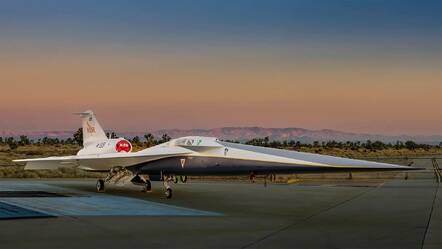NASA’s X-59 quiet supersonic aircraft made its public debut on Friday in a media event at the Lockheed Martin Skunk Works in Palmdale, California, where the plane was designed.
The X-59, the centerpiece of NASA’s Quesst mission, was designed to fly at supersonic speed without the sonic boom created by planes breaking the sound barrier. The US Federal Aviation Administration banned civilian aircraft from exceeding the sound barrier on April 27, 1973, citing the need to protect people and property from sound and shock waves.
NASA believes the problem can be addressed by better engineering. Instead of the shock-and-awe of a window-rattling, animal-startling thunderclap of a sonic boom, the X-59 was designed to produce a quieter “thump,” which the aviation and space agency has likened to the sound of a car door being closed.
“Today, supersonic flight brings a thunderous sonic boom,” said NASA Deputy Administrator Pam Melroy before the assembled audience.
“Those of us who live in the area are familiar with this sound. But what that means is that’s restricted across populated areas, with good reason. And the X-59 is going to break that barrier.” You can see the whole launch below.
Youtube Video
“Meticulously engineered, it produces a gentle bump, a mere whisper compared to the disruptive booms of the past,” said Melroy. “So this breakthrough really redefines the feasibility of commercial supersonic travel over land. It brings us closer to a future that we can all understand: cutting flight time from New York to Los Angeles in half.”
NASA’s goal with the X-59 is to convince the FAA and other aviation authorities to rewrite their regulations based on sound levels, rather than aircraft speed. Dialing down the decibels of supersonic flight, NASA hopes, will convince the government that subtly surpassing the speed of sound should be allowed, which could be a boon for civilian and military aviation.
The cost of the X-59 program, including testing, over eight years is reportedly about $632 million. The initial contract for the program, which NASA awarded to Lockheed in 2018, was for $247.5 million. At the time, Lockheed hoped to deliver the plane by 2022.
The X-59 is scheduled to fly for the first time later this year, and after testing supersonic flight will be attempted. The pointy plane is designed to reach Mach 1.4, around 925 mph. Large passenger jets commonly cruise at speeds ranging from Mach 0.78 to Mach 0.81, or 575-600 mph.
The now-retired Concorde, which was flown by Air France and British Airways, offered supersonic passenger flights from 1969 until 2003. It could reach speeds of Mach 2, or about 1,350 mph. But the July 25, 2000 fatal crash of Air France Flight 4590, the ensuing economic consequences, parts availability problems, and other factors like travel impact of the September 11, 2001 terrorist attack, led Air France and British Airways to retire the plane in 2003.
Once NASA establishes that the X-59 can fly quickly and quietly, the US space agency intends to conduct test flights over several as-yet-undetermined populated areas and then collect feedback from local residents. The results will then be passed on to the FAA and international aviation authorities to make the case for the acceptability of sonic thumps in the future.
The X-59 isn’t a serious passenger plane, or even a prototype of one; rather it’s an experimental design that’s intended to prove technology that can be implemented in future aircraft. Measuring 99.7 feet long and 29.5 feet wide, the X-59 is almost one-third nose – the plane’s prominent proboscis serves to break up the shock waves that would otherwise merge together to cause a sonic boom.
The plane’s engine was top-mounted on the tail as another sound mitigation technique, according to NASA.

The X-59 aircraft, which lacks a front windscreen – Click to enlarge. Source: Lockheed Martin.
The view from the cockpit leaves something to be desired in that there’s no forward-facing window. Instead pilots will see through what NASA calls the “eXternal Vision System,” a 4K monitor fed by a set of high-resolution video cameras.
According to Melroy, the absence of a front-facing window was a deliberate engineering decision to keep the plane quiet. And she believes that innovation may prove useful for other aircraft designs.
“Beyond its immediate applications for the X-59, the external vision system has the potential to influence future aircraft designs, where the absence of that forward facing window may prove advantageous for engineering reasons as it did for us,” she said.
The X-59, she said, is the culmination of decades of engineering research into mitigating the sonic boom. “I’m really personally thrilled about this engineering marvel taking flight,” she said. ®
